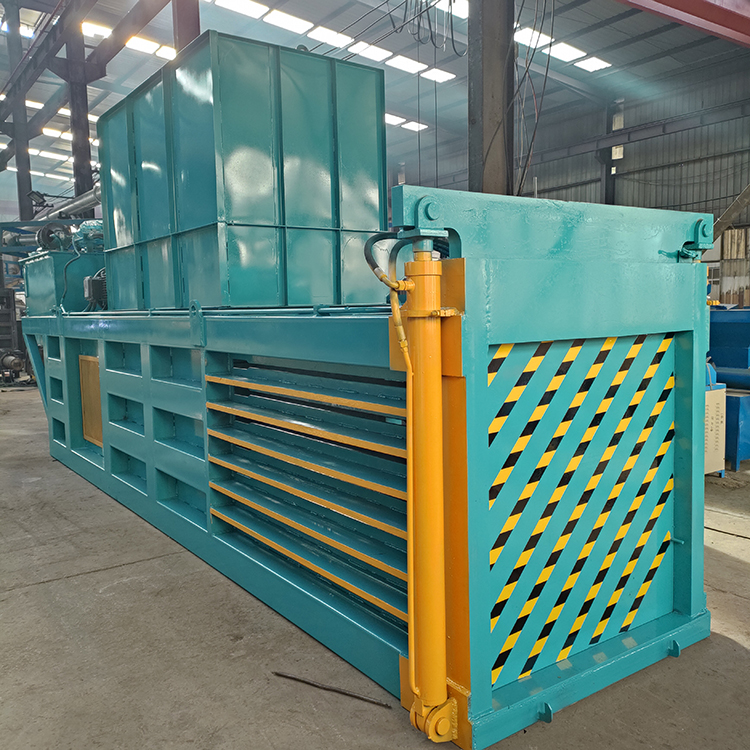Innovations in Horizontal Baler Technology: Recent Developments and Applications
Date:2024-08-28
View: Point
Introduction
A horizontal baler is designed to compress materials horizontally, typically using hydraulic or mechanical force. The materials being compressed can vary widely, including paper, cardboard, plastic, textiles, aluminum cans, and more. The process not only reduces the volume of these materials but also makes them easier to handle and transport.

Application Principle
The principle behind a horizontal baler involves several key components:
- Feeding System: Materials are fed into the baler through an opening. This can be done manually or with the assistance of conveyor belts.
- Compression Mechanism: Once inside, the materials are pushed by a plunger or ram that applies significant force to compress the materials. The compression chamber is designed to apply pressure from one side, hence the term "horizontal."
- Baling Wire or Strapping: After the materials have been sufficiently compressed, they are tied off using wire, strapping, or another binding material to hold the bale together.
- Ejection System: The bale is then ejected from the machine, and the cycle repeats with new materials being fed into the baler.
Benefits
- Volume Reduction: Reduces the volume of waste materials, making storage and transportation more efficient.
- Cost Savings: Can lead to reduced disposal costs and potentially generate revenue if the baled materials can be sold as recyclables.
- Environmental Impact: Promotes recycling and waste reduction, contributing to sustainability efforts.
Applications
Horizontal balers are commonly used in:
- Manufacturing Facilities: For managing scrap materials and packaging waste.
- Recycling Centers: To process large volumes of recyclable materials.
- Retail Stores and Supermarkets: To manage cardboard boxes and other packaging waste.
- Warehouses: For compacting and organizing shipping materials.
Zhongcheng Machinery Will Be There Whenever Wherever Whatever You Need
You Are Welcome to : phone call, Message, Wechat, Email& Seaching us, etc.
Email:
sales@zchmachinery.com
Whatsapp/Phone:
+8618738194110
Prev:
What is RDF fuel rods?
hot Products
-
 Trommel screenTrommel screen, also known as drum screens, are widely used in various industries for sorting and separating materials.Get Quote
Trommel screenTrommel screen, also known as drum screens, are widely used in various industries for sorting and separating materials.Get Quote -
 Crop straw double shaft shreddApplications:Biomass Energy Production: Shredded straw can be used as a feedstock for bioenergy plants to produce electricity or heat.Livestock Feed: Reduced-si...Get Quote
Crop straw double shaft shreddApplications:Biomass Energy Production: Shredded straw can be used as a feedstock for bioenergy plants to produce electricity or heat.Livestock Feed: Reduced-si...Get Quote -
 Zhongcheng Air Drum SeparatorAir drum separators effectively separate lightweight materials (e.g., plastics, paper) from heavier materials (e.g., metals, glass). This high efficiency is cru...Get Quote
Zhongcheng Air Drum SeparatorAir drum separators effectively separate lightweight materials (e.g., plastics, paper) from heavier materials (e.g., metals, glass). This high efficiency is cru...Get Quote
relate news
-
2024-08-05Hot-sell Coconut Shredderworking principleCoconut shell shredder usually uses the force generated by cone and spiral to evenly squeeze the coconut meat in the grinding chamber between t...
-
2024-06-11Optimize Your Waste Management Today with Our Advanced Drum ScreensUnderstanding the Mechanism and Optimization of Drum Screens for Waste Management
-
2023-01-12WindshifterWindshifter (Air Drum Separator ) is the ideal solution for separating all kind of waste types into two fractions, heavy and light. The robust construction and ...
-
2025-04-21Compact Copper Cable Granulator MachineThe compact copper cable granulator machine is a device used to recycle waste wires and cables. It separates the copper wire from the plastic sheath by crushing...
-
2023-01-12Conveyor BeltGarbage conveyor/Trash conveyor belt system is a processing line to classify paper, plastic, metal, glass, and organic matter and realize the recycling of rubb...



